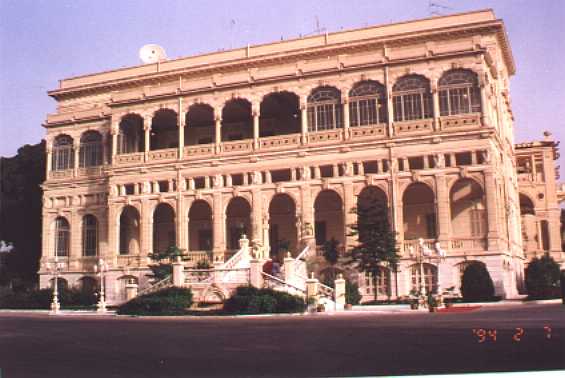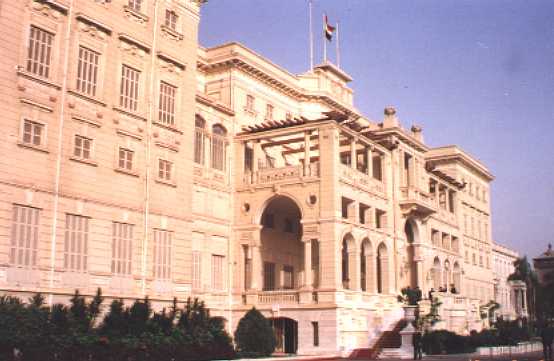
|
|
|
|
|
Cheers to our "talented" literature prize awardee. Your pain his gain !!!
|
|
|
EGY.COM - LANDMARKS - CAIRO - HELIOPOLIS
|
|
|
|
|
Cairo Times, 2 February 2000 |

The Garden of a Thousand Delights is how Prince Mohammed Ali described the 400-room Italianate palace allegedly built by his father who ruled Egypt from 1879 until 1892. Khedive Mohammed Tewfik's second son was referring to Koubbeh* Palace where he was born in 1875.
Situated several kilometers north of downtown Cairo, Koubbeh Palace (so named in reference to the dome--Koubbeh of a nearby mosque) was at the time surrounded by agricultural fields and rural villages. Access to and from the city was through a cobbled carriage road that passed through Shubra, then a sprawling suburb.
According to Prince Mohammed Ali, the main palace building "haramlek" overlooked 70 acres of gardens filled with tropical plants. Part of the garden was used as an acclimatization center for flowers, shrubs and trees brought from all over the globe. Pavilion and jasmine-covered kiosks where everywhere. While some of these were built with sliding screens made of wooden lattice--mashrabeya ensuring the privacy of princesses and palace maidens, others had copper roofs that gleamed like jewels in the sunshine and during a full moon. All had rich cushions of silk and satin strewn with seed pearls so residents and guests alike could play chess-shatarang, draughts--dameh or backgammon-tawlah in absolute comfort.
Under Khedive Tewfik, Koubbeh Palace was a venue for One Thousand And One Night celebrations, royal weddings, and a place where visiting dignitaries admired magnificent gardens. During his son's rule (Khedive Abbas Hilmi II; r. 1892-1914) the garden palace gradually came to be regarded as complementary to Cairo's Abdin Palace in terms of officialdom.
When King Fouad ascended Egypt's throne in 1917 Koubbeh became the official royal residence. By then a royal train station had been added to the palace complex whereby visiting dignitaries arrived by special carriage directly from Alexandria or from Cairo's main railway station. During his reign, King Fouad ordered numerous enhancements and extensions to Koubbeh including a six-meter wall around the 75-acre, a new gate and an external garden.
It was a few days after King Fouad died at Koubbeh Palace that his 16 year-old son Farouk greeted his subjects during a momentous inaugural radio broadcast on 8 May 1936. Now that wireless technology had become an established means of interacting with the public at large, a special radio transmitter was installed in Koubbeh. This tuning point in communications would have its match forty years later when Egypt's first ever live satellite transmission went out from Koubbeh Palace during US President Richard Nixon's state visit.
Considering it his private residence, King Farouk kept his personal collections at Koubbeh. These priceless treasures encompassed a precious stamp collection, an 8,500-piece coin and medals collection, studded clocks and watches, in addition to many other beautiful antiquities including a pure gold coffee set and a 1906 Faberge egg that belonged to the last Russian Czar. Much of these were auctioned off in 1954 as evidenced by front-page advertisements placed in most of the contemporary newspapers.
After the toppling of the monarchy in 1952, Koubbeh Palace was earmarked one of three official presidential palaces, the other two being Abdin in downtown Cairo and Ras El Tine in Alexandria. If Koubbeh came third in terms of opulence it was nevertheless there that Gamal Abdel Nasser preferred to host his official guests. It was also there that his body lay awaiting his historic funeral in September 1970.
To this day Koubbeh remains Egypt's principal guesthouse. African chiefs have stayed there, Chinese leaders helped themselves to cuttings from the gardens, Arab potentates admired and later copied the staterooms, and European prime ministers including Britain's Tony Blair found time to enjoy the sun in one of the numerous palace balconies.
Strangely enough, the longest staying head of state to reside at Koubbeh since the days of King Farouk was none other than his former brother-in-law. But then Koubbeh palace was déjà vu for the ousted Shah of Iran for it was there that he had stayed, and later sipped tea with Egypt's queen mother, when he celebrated his March 1939 wedding to Farouk's sister, the Princess Fawzia. Since then lots of water had crossed under the Garden of a Thousand Delights.
* Also spelt: Kobba, Kubba, Qubbeh; pictures courtesy of Dr. Rudolf Agstner


MORE HELIOPOLIS STORIES
Vintage Heliopolis photos
Yes of course I think these palaces should be turned into museums
Turning palaces into Museums: this is the least we can do towards preserving our national hritage & history
Palaces are part of art and culture, so they must be opened to public
to attract people from outside egypt to visit these beautiful palaces you should seriously maintain them in the best shape possible
Those buildings were built by the people's blood and money and exploitation, so, it is the right of the people to reclaim them back for their children
I believe the palaces should be returned to their rightful owners: the Egyptian Royal Family!
Kobbeh Palace: SEQUENCE OF OWNERSHIP
NO WONDER THEY SUNBATHE
ITS GUARDIANS ARE ALSO ITS PLUNDERERS
KEEP THE PEOPLE OUT!
JUDGE FOR YOURSELF! Date: Sat, 18 Mar 2000 19:13:10 GMT+00:00 From: "Peter Shaw-Smith" <petess@gega.net>
Answer: El Nassriya School is a travesty of architectural conservation. This
Italianate
turn of century palace (arch. Antonio Lasciac) was built for Saiid Halim Pasha a grandson of Mohammed Ali. He was the only Egyptian-born prince to reach the highest public office in the Ottoman Empire when he became "al-Sadr al-Aazam" Ottoman equivalent of Prime Minister. He operated out of Yidliz Saray in Istanbul (seat of Ottoman government a.k.a. Sublime Porte). And yes, his Cairo palace gardens did extend to Champolion Street. In view of Saiid Halim's position he was proclaimed "enemy alien" by Egypt's de facto British rulers on eve of WW1 and his palace turned into a school for high-born boys. Many a future Egyptian politician was educated at Nassriya.
Heliopolis 1913 survey map
Heliopolis Palace Hotel (Presidential Palace)
Baron Empain's Hindu Palace
Heliopolis residents in 1913-14
Heliopolis pharmacies in 1946
An important Belgian legacy
When Maadi very nearly replaced Heliopolis
The making of Koubbeh Gardens
Reader Comments
As a member of Mehmet Ali Pasha's family, I would rather the public saw the palaces than the usupers live in them!
12/1/00 6:47:47 PM
10/26/00 3:21:14 AM
6/18/00 1:20:02 AM
4/25/00 12:28:54 AM
4/17/00 5:55:00 PM
4/12/00 4:45:34 PM
4/6/00 2:05:21 PM
After the appearance of this article its writer learned from Princess Ulvia Abbas Halim Koubbeh Palace, perhaps in much smaller form, was originally the property of the Fazil branch of the House of Mohammed Ali. Through her grandmother (Princess Ulfet Fazil) Princess Ulvia is a descendant of that branch. The writer of this article would also like to thank Mr. Amr Talaat and Mr. Mike Topsakal for their valued cooperation.
As a senior Nordic diplomat I stayed at Koubbeh palace with my president who was on a state visit to Egypt. It was very cold. There were no plugs for heaters or hair dryers. Moreover, warm water was only available in the evening. Was this the case during the times of King Fouad?
Brrrrrrr
Reference to your article I would like to point out that if priceless palace contents were openly auctioned out by the state, other valuables simply disappeared. Since the public has never been allowed inside the palace, one can only deduce the guardians of the state treasury are also its plunderers. Equally interesting is that some paintings hanging at Koubbeh palace belonged to private collections confiscated by the state back in the 1960s. For instance a Jean-Leon Gérome painting dedicated to Cherif Pasha showing the island of Roda and the palace wall of Sulayman Fransawi was identified as having belonged to the descendants of Cherif Pasha. How it made it from Abdelrehim Sabry Pasha's Nawal Palace in Giza to Koubbeh remains a mystery.
R.A.
The wall around Koubbeh Palace. According to Shafik Pasha's memoirs, its construction supposedly caused a major shortage of bricks in Egypt.
Hassan Kelesli
In 1954 the state decided to auction King Farouks' private numismatic collection at Koubbeh Palace. A truly unique coin collection if there was any. To illustrate what happened to what could, and should, have been part of Egypt's national heritage, read on: Four coins were sold to John Jay Pittman (Lot 249) for US$ 454.00 and another three coins (lot 251) for US$ 514.00. All seven coins were sold for US$ 224,950.00 at an auction in the United States two and a half decades later.
King Farouk's collection consisted of over 1,000 rare coins!
From: don.foreman@talk21.com
I have just looked at your web site, and found it very interesting. As I am the Secretary-General of the International Monarchist League, I find the articles about the former palaces of particular interest. You ask whether former palaces should be turned into museums and open to the public. In my opinion, what would be even better would be for the monarchy to be restored and the palaces occupied by the Royal Family - the purpose for which they were built! The most important rooms could then be open to the public when the family is not in residence. That is what happens here in the UK at Buckingham Palace, Windsor Castle, Holyrood House etc. Do you think there is any support in Egypt for restoration of the monarchy? Do you know of any pro-monarchy organisation or individual I could write to on this subject? If you want to know more about the Monarchist League please look at our web site:-
http://www.monarchy.net With good wishes,
Don Foreman
Subject: Nassiriya School in downtown Cairo
Date: Mon, 11 Sep 2000 22:25:32 +0300
I couldn't help myself looking around the Nassirya School on Champolion
Street on Saturday. Amazing, it's fate. It must have been stunning in its prime - some teachers were around - not very inclined to talk, tho' one said the
lawns stretched right down to Tahrir in their day and pointed to ovals in the ceilings that now have paint slapped over them. He pointed out the H superimposed on S logo for the new contraption. Ca you tell us more about that shcool?
|
|
|
|